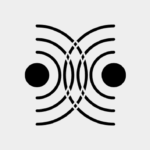BETTER GEOMETRY
The design of a cable must be mechanically stable, generate a homogeneous electromagnetic field between and around the conductors and ensure a time-correct and loss-free signal flow.
Efforts to counteract mutual interference using complex stranding and braiding techniques often fail.
Twisted constructions reduce susceptibility to interference and typically lead to a low inductance, which is usually the aim. However, as soon as current flows through a wire, its own electromagnetic field is generated. If the cores are twisted, the electromagnetic fields of the individual wires are close together over a large area. They act on each other and impair the flow of electrons. This is why solid conductors are often used instead of stranded wires.
Although braided constructions typically reduce susceptibility to interference, they accept the effects of a permanent change in the electrical environment of the individual conductors in relation to each other. This leads to unwanted electromagnetic effects that impair the flow of electrons.
Parallel constructions with parallel conductors are less resistant to external interference fields and favor the proximity effect. This impairs the flow of electrons by creating eddy currents.
In order to achieve a uniform and unrestrained electron flow, the electrical parameters and the electromagnetic fields should remain as constant and homogeneous as possible over the entire length. The requirement for the mechanical stability of the structure is often underestimated, although it plays an important role in maintaining constant conditions.
For example, the current flow and the sound energy in the room cause the individual conductors in the cables to micro-oscillate. As a result, their distances from each other and therefore the electromagnetic fields are constantly changing. These micro-oscillations also cause the crystal structure to resonate, which distorts information. Mechanical stability is a factor that is usually underestimated in interwoven constructions, as the spaces between the wires leave room for vibrations.
Regardless of the individual design, even in the highest price range, industrially prefabricated or machine-wound designs are generally used, all of which have the limitations of a constant winding technique due to the machine. This has a limiting effect on the avoidance of electrical interference in relation to different frequency spectra and the avoidance of electrical and mechanical signal conductor and cable resonances.
On the subject of outer sheathing, a word about static problems: In many places, plastic fabric hoses are used as outer sheathing. They look stylish, are inexpensive and make production easier. However, the fact is that the outer sheathing definitely affects the sound quality of a cable. In the case of plastics, for example, static charges can occur that impair the transport of electrons. As a “tuning measure”, antistatic agents are often offered as accessories to compensate for the shortcomings of these materials.
The SCHNERZINGER approach:
In order to fully utilize the advantages of closely interwoven designs without accepting their problems (electromagnetically inconstant conditions and an uneven, slowed-down electron flow), Schnerzinger relies on costly and time-consuming manual winding of the conductor geometry, in which the non-uniformity is precisely determined. As a result, electromagnetic effects are comprehensively controlled and susceptibility to interference is uncompromisingly reduced.
With regard to the outer sheathing, SCHNERZINGER has tested many possible materials in the development series. These include various plastics, the best types of polyethylene, unbleached cotton, different types of silk, carbon and much more. SCHNERZINGER uses an industrial braid that achieves outstanding results after a special tempering process.

